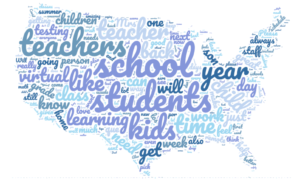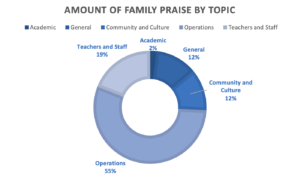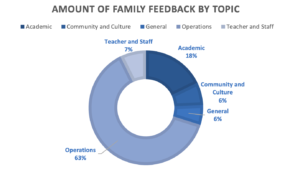During the pandemic, parents took on an essential role in virtual learning and became more engaged in the academic progress of their children. As students return to the classroom, school leaders have the opportunity to keep this momentum going and partner with parents in monitoring student progress. Many parents appreciate the value of this increased involvement in their children’s education. However, they are looking for schools to make it easier to share academic progress with families. We’ve also heard in our Possip Pulse Check family trends that parents are asking to be updated more frequently.
What can school leaders do both from a technology perspective and standardized approach to help keep parents engaged in the process? Here are three big tips for keeping families feeling updated:
1. Create & Share the Clear Grading Philosophy
All schools should have a clear grading philosophy and share that with teachers, families, and students. Is it pure grading (i.e. a missing assignment) or is it contextualized and accounting for potential barriers (i.e. why this student is missing an assignment? Is it possible that they didn’t have technology or we didn’t set expectations or need? How your school grades and what grades mean will be essential to families feeling up-to-date with their student’s academic progress.
In addition to having your school’s grading philosophy clear to your community, give families information about who to go to if they have questions about their child’s grades, how their student can improve or change their grade, and ensure families understand the difference between grades and academic progress (if applicable). Families do not only want to clearly understand where their students are in terms of grades. They want to know if they are on-track comparatively to other students and if the curriculum is appropriately challenging By creating and sharing your school’s grading systems and philosophies, the clarity of grades will spark conversations about many other beneficial topics that lead to student success.
Here are a few Edutopia articles on grading philosophies if you want to read more on this topic:
- https://www.edutopia.org/article/do-no-zero-policies-help-or-hurt-students
- https://www.edutopia.org/discussion/our-grading-system-fair
- https://www.edutopia.org/article/whats-wrong-points
2. Standardize Communication & Grade Reporting Dates
One thing we hear often from parents is this teacher does this and this one does that. It is hard to keep up with. It is best for parents (and school leaders) if there are standard processes for notification of assignments and entering grades. A few options here include:
- Enter Grades at Beginning of the Week: Enter empty grades by Monday morning for the entire week. This lets parents know exactly what the graded assignments are for the week.
- Set a Date: Set a specific day each week for all missing assignments to be entered. This works best if it is Friday. Then students can get caught up over the weekend when there are no new assignments. Having set dates keeps teachers, students, and families accountable to that norm. Additionally, set a specific day for all teacher to enter grades. When this happens consistently, families know when they need to follow up. They will also make sure their student is mastering the concepts.
- Send Home Syllabi: Send home syllabus or curriculum expectations/calendar. This can also include graded assignments. This can be done weekly or monthly, just depending on what works best and is reasonable for teachers.
- Create Campus Communication Norms: Create and publish specific guidelines for when teachers will communicate with parents about student progress. For example, if a student has a missing assignment, the teacher sends an email. If a student’s average falls below a 60%, the teacher calls the parent. Share these guidelines with parents so they are not wondering why or why not the school has not contacted them.
- Clear Teacher Conference Metrics: Establish metrics for teacher initiated conferences. Families can trust that not wondering if they will need a conference. The conference guidelines are available to families and encourage them to continue to follow progress using school based tools. If a conference is needed, the parent is more prepared. It will also be easier to come up with a plan to improve student progress.
3. Provide Tools & Resources for Families:
Families that have access to technology and updated grades will feel a lot more connected to their student’s academic progress. Here are a few tools to share with parents:
- Access to Grades Online: Using online platforms is a great way to share academic progress with families. If your technology allows, parents should have access to report cards and progress reports or grade updates online. Make sure they know their log-ins and passwords. They should also have a campus contact if they have questions about the grade portal.
- Report Card Calendar: Have a set calendar for hard copy report cards and progress reports to be sent home. Make sure to share these dates with parents.
- Instructions to Log-in to Grading Portal: Remind parents how to log-in to grade technology platforms to check when they need it–resend log-in info. Create multiple forms of instruction including written and video and create translated versions as well.
- Staff Directory: Keep an updated staff directory online and make sure all parents have teacher emails and require a 48 hour response time for teachers to respond to families.
Schools can provide resources to families and standardize processes to share academic progress with families. This will help parents and family members have greater clarity and build a strong partnership with teachers.
The post Three Key Points To Share Academic Progress with Families appeared first on Possip | Parent Engagement Platform | School Feedback App.


 ” Which translated says, “I would like to thank Mr. Olson …. he has taken the trouble to offer to pick up my son this week so that he can attend his exams because I am working and it is difficult for me to take him, so I am infinitely grateful.
” Which translated says, “I would like to thank Mr. Olson …. he has taken the trouble to offer to pick up my son this week so that he can attend his exams because I am working and it is difficult for me to take him, so I am infinitely grateful.











